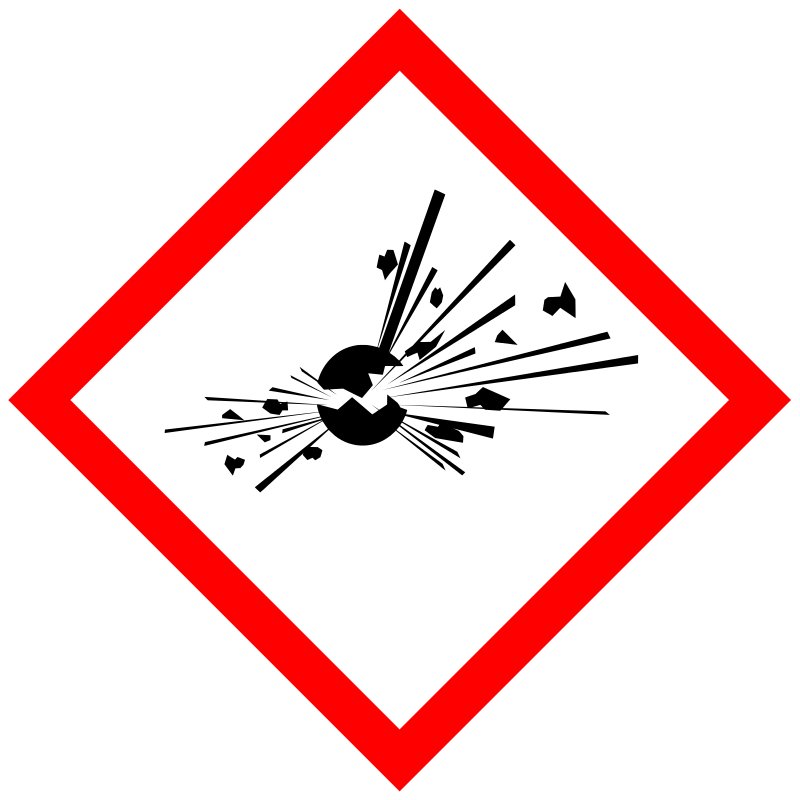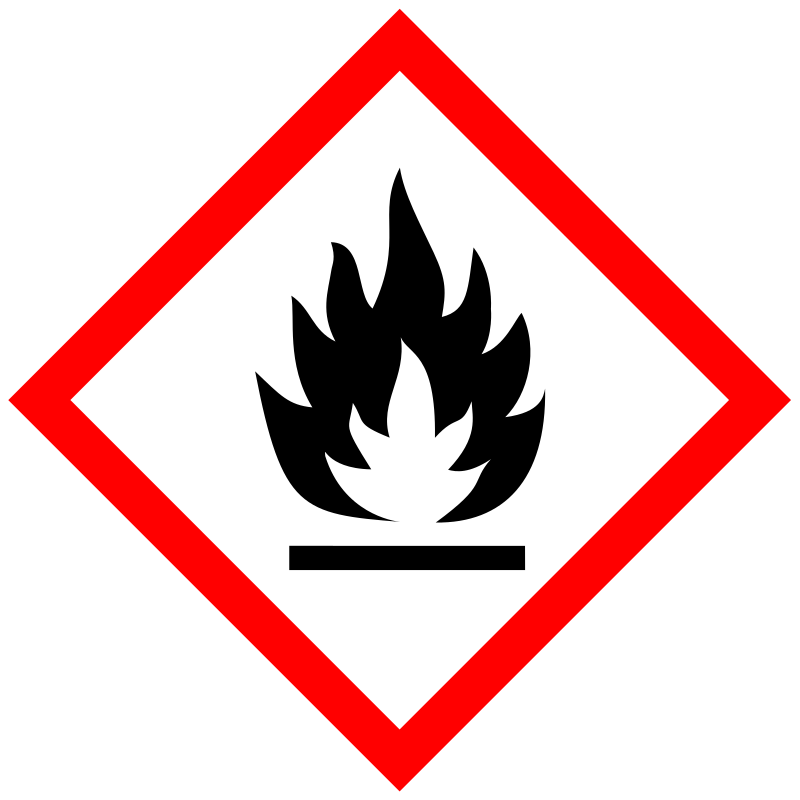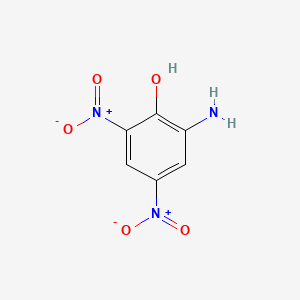D0659 | 2-amino-4,6-dinitrophenol
| Toxicity | Dose | Time | Species | Model | Method | Action | Positive criterion | Reference |
|---|---|---|---|---|---|---|---|---|
| MEMBRANE POTENTIAL | 4.18±2.00 | human | qHTS-HepG2 | MMP assay | decrease | IC50 | 163 | |
| MEMBRANE POTENTIAL | 15.85 | human | HepG2 | MMP assay | decrease | IC50 | 163 | |
| MEMBRANE POTENTIAL | 28.80±15.58 | rat | hepatocytes | MMP assay | decrease | IC50 | 163 | |
| Pictogram | Signal | Statements | Precautionary Statement Codes |
|---|---|---|---|
  |
Danger |
H201: Explosive mass explosion hazard [Danger Explosives] H302: Harmful if swallowed [Warning Acute toxicity, oral] H312: Harmful in contact with skin [Warning Acute toxicity, dermal] H332: Harmful if inhaled [Warning Acute toxicity, inhalation] H412: Harmful to aquatic life with long lasting effects [Hazardous to the aquatic environment, long-term hazard] |
P210, P230, P240, P250, P261, P264, P270, P271, P273, P280, P301+P312, P302+P352, P304+P312, P304+P340, P312, P322, P330, P363, P370+P380, P372, P373, P401, and P501; (The corresponding statement to each P-code can be found at the GHS Classification page.) |
 |
Warning |
H302: Harmful if swallowed [Warning Acute toxicity, oral] H312: Harmful in contact with skin [Warning Acute toxicity, dermal] H332: Harmful if inhaled [Warning Acute toxicity, inhalation] H412: Harmful to aquatic life with long lasting effects [Hazardous to the aquatic environment, long-term hazard] |
P261, P264, P270, P271, P273, P280, P301+P312, P302+P352, P304+P312, P304+P340, P312, P322, P330, P363, and P501; (The corresponding statement to each P-code can be found at the GHS Classification page.) |
  |
Danger |
Aggregated GHS information provided by 84 companies from 6 notifications to the ECHA C&L Inventory. Each notification may be associated with multiple companies. H201 (95.24%): Explosive mass explosion hazard [Danger Explosives] H302+H312+H332 (45.24%): Harmful if swallowed, in contact with skin or if inhaled [Warning Acute toxicity, oral acute toxicity, dermal acute toxicity, inhalation] H302 (100%): Harmful if swallowed [Warning Acute toxicity, oral] H312 (100%): Harmful in contact with skin [Warning Acute toxicity, dermal] H332 (100%): Harmful if inhaled [Warning Acute toxicity, inhalation] H412 (100%): Harmful to aquatic life with long lasting effects [Hazardous to the aquatic environment, long-term hazard] Information may vary between notifications depending on impurities, additives, and other factors. The percentage value in parenthesis indicates the notified classification ratio from companies that provide hazard codes. Only hazard codes with percentage values above 10% are shown. |
P210, P230, P240, P250, P261, P264, P270, P271, P273, P280, P301+P312, P302+P352, P304+P312, P304+P340, P312, P322, P330, P363, P370+P380, P372, P373, P401, and P501; (The corresponding statement to each P-code can be found at the GHS Classification page.) |
  |
Danger |
H201: Explosive mass explosion hazard [Danger Explosives] H302: Harmful if swallowed [Warning Acute toxicity, oral] H312: Harmful in contact with skin [Warning Acute toxicity, dermal] H332: Harmful if inhaled [Warning Acute toxicity, inhalation] H412: Harmful to aquatic life with long lasting effects [Hazardous to the aquatic environment, long-term hazard] |
P210, P230, P240, P250, P261, P264, P270, P271, P273, P280, P301+P312, P302+P352, P304+P312, P304+P340, P312, P322, P330, P363, P370+P380, P372, P373, P401, and P501; (The corresponding statement to each P-code can be found at the GHS Classification page.) |
 |
Warning |
H228: Flammable solid [Danger Flammable solids] |
P210, P240, P241, P280, and P370+P378; (The corresponding statement to each P-code can be found at the GHS Classification page.) |
| 070A534 | 1-Amino-2-hydroxy-3,5-dinitrobenzene | 2,4-Dinitro-6-aminophenol |
| 2-AMINO-4,6-DINITRO PHENOL | 2-Amino-4,6-Dinitrophenol, wetted with not <20% water by mass | 2-Amino-4,6-Dinitrophenol, wetted with not <20% water by mass [UN3317] [Flammable solid] |
| 2-Amino-4,6-Dinitrophenol, wetted with not <20% water by mass [UN3317] [Flammable solid]; | 2-Amino-4,6-dinitrophenol | 2-amino-4,6-dinitro-phenol |
| 2-azanyl-4,6-dinitro-phenol | 4,6-DINITRO-2-AMINOPHENOL | 4,6-dinitro-2-amino-phenol |
| 4-13-00-00909 (Beilstein Handbook Reference) | 5VDQ7GK8L3 | 6-Amino-2,4-dinitrophenol |
| 96-91-3 | A845654 | AC-11460 |
| ACT07496 | AE-641/00206029 | AI3-08922 |
| AKOS000120580 | Acide picramique | Acide picramique [French] |
| BBL028138 | BRN 0989416 | C.I. Oxidation Base 21 |
| CAS-96-91-3 | CCRIS 1003 | CHEMBL3183248 |
| CI 76540 | CI Oxidation Base 21 | D0813 |
| DB-020415 | DSSTox_CID_4479 | DSSTox_GSID_24479 |
| DSSTox_RID_77418 | DTXSID5024479 | EINECS 202-544-6 |
| Ex073 | Fourrine 4R | Fourrine 93 |
| Furro 4R | HSDB 4319 | LS-2014 |
| MCULE-4569162230 | NCGC00260433-01 | NE11171 |
| NSC 36939 | NSC-36939 | NSC-4861 |
| NSC36939 | NSC4861 | Oxidation Base 21 |
| Phenol, 2-amino-4,6-dinitro- | Picramic acid | Pikraminsaure |
| Q283711 | QXYMVUZOGFVPGH-UHFFFAOYSA-N | SBB058601 |
| SCHEMBL18124 | ST4032788 | STK711606 |
| Tox21_202887 | UN3317 | UNII-5VDQ7GK8L3 |
| VS-08677 | VZ23602 | ZINC1316284 |
| Zoba 4R |
| CAS Number | 1134-85-6, 96-91-3 |
| PubChem Compound | 4921319 |

